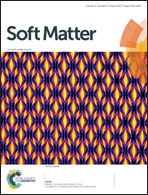Facile fabrication of Sudan red particle microcapsules by a polymerizable gemini surfactant and molecular assembly mechanisms†
Abstract
An efficient method was developed to encapsulate water insoluble organic particles of Sudan red III (SR) in aqueous suspensions by using a polymerizable cationic gemini surfactant, 1,3-bis(N,N-dimethyl-N-cetylammonium)-2-(propylacrylate dibromide) (AGC16). The AGC16 coated SR microcapsules (AGC16@SR) were prepared by absorption of AGC16 on the surface of SR, followed by in situ homopolymerization (PAGC16). Several measurements, including transmission and scanning electron microscopy, isothermal titration calorimetry, zeta potential, electron paramagnetic resonance and small angle X-ray scattering, were performed to determine the adsorption amount of AGC16, and the layer structures and the molecular assembly mechanism in the AGC16@SR and PAGC16@SR systems, respectively. For comparison purposes, the polymerizable cationic surfactant with one head group and a single alkyl chain, acryloyloxyethyl-N,N-dimethyl-N-cetylammonium bromide (referred to as ASC16), as well as the systems of ASC16@SR and PASC16@SR were also investigated in parallel. It was found that AGC16 molecules and their aggregates were simultaneously assembled into a shell layer, in which the saturated adsorption amount of AGC16 on SR is less than 1/2 that of ASC16, but the assembly layer of AGC16 is more hydrophobic with greater packing tightness compared with that of ASC16. It was also revealed that after in situ homopolymerization, the microcapsule shell becomes more compact. In the case of PAGC16@SR, the layers show higher surface roughness and irregularity compared with that of PASC16@SR. Moreover, the sustained release behavior of SR was also evaluated. The results revealed that PAGC16@SR performed well for SR controlled release, which was sorted by release performance as the following sequence: PAGC16@SR > AGC16@SR > PASC16@SR > ASC16@SR. Thus, the polymerizable cationic gemini surfactant holds substantial potential to be developed as an ideal candidate of soft matter to construct efficient controllable release systems.



 Please wait while we load your content...
Please wait while we load your content...